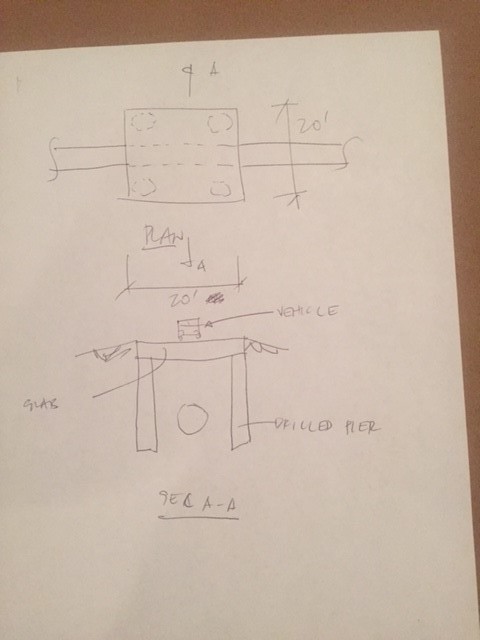delagina
Structural
- Sep 18, 2010
- 1,008
I'm designing a slab approx. 20'x20' supported by drilled piers.
This is to protect the pipe underneath.
This is a private slab/road and vehicles passing are pick up trucks.
I want to keep this calculation simple and not do any moving loads.
I can design the slab easily with static point load, run it a few times with different point loads location that I think are the critical locations.
1) I am not sure though what static point load to use per vehicle rating or vice versa. Is there a guide to this?
Client wants a vehicle rating for the slab.
2) client wants this slab removable. I guess to service the pipe in the future.
Can someone link a vendor for a lifting eye that I can use that will not protrude so it wont get hit by vehicles.
3) if slab is removable then it is just bearing on top of drilled pier. only the friction on top of pier and soil passive pressure will prevent it from moving.
will that be enough, I imagine there aren't much horizontal force here?

This is to protect the pipe underneath.
This is a private slab/road and vehicles passing are pick up trucks.
I want to keep this calculation simple and not do any moving loads.
I can design the slab easily with static point load, run it a few times with different point loads location that I think are the critical locations.
1) I am not sure though what static point load to use per vehicle rating or vice versa. Is there a guide to this?
Client wants a vehicle rating for the slab.
2) client wants this slab removable. I guess to service the pipe in the future.
Can someone link a vendor for a lifting eye that I can use that will not protrude so it wont get hit by vehicles.
3) if slab is removable then it is just bearing on top of drilled pier. only the friction on top of pier and soil passive pressure will prevent it from moving.
will that be enough, I imagine there aren't much horizontal force here?


![[idea] [idea] [idea]](/data/assets/smilies/idea.gif)
![[r2d2] [r2d2] [r2d2]](/data/assets/smilies/r2d2.gif)